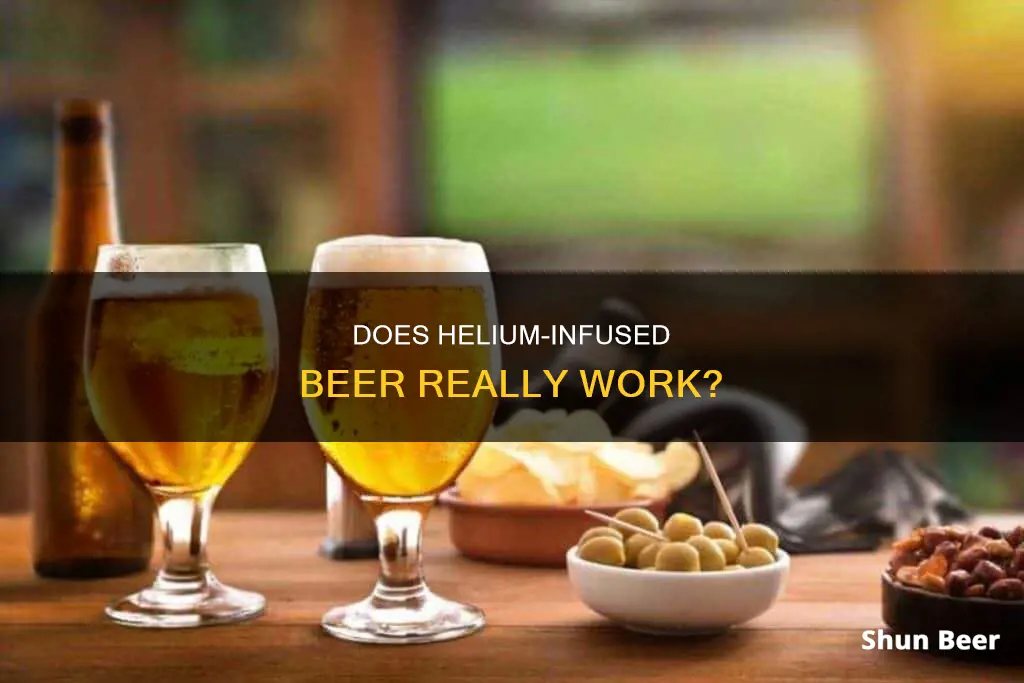
The idea of helium-infused beer gained popularity due to viral videos showcasing beers that could change drinkers' voices to a high-pitched squeak. However, these videos were revealed to be April Fool's Day jokes. While infusing helium into beer is technically possible, it is not feasible due to the laws of thermodynamics and physical chemistry.
| Characteristics | Values |
|---|---|
| Possibility | Technically possible to infuse helium into beer, but unlikely to be drinkable. |
| Drinkability | Not possible to create a drinkable helium-infused beer due to laws of thermodynamics and physical chemistry. |
| Solubility | Helium is not soluble in water, unlike carbon dioxide and nitrogen. |
| Freezing Point | Liquid helium turns to gas at -220°F, which would freeze the beer. |
| Gushiness | Even if infused, helium would cause gushing as it is not soluble in beer. |
| Voice-Changing Properties | The pitch of the drinker's voice would not be affected by drinking helium-infused beer. |
| Market Availability | Not available to purchase, aside from non-alcoholic options. |
What You'll Learn

The helium beer hoax
In 2014, two beer companies, Samuel Adams and Stone Brewing Co., released videos announcing new helium-infused beers. The videos, released on April 1st, were, of course, April Fool's jokes. However, they sparked huge interest online, with people eager to get their hands on the unique brew.
The idea of a beer that could change the pitch of your voice was clearly an appealing one. The videos showed people allegedly drinking helium beer and then speaking in high-pitched voices. This, combined with the fact that the videos seemed quite earnest, meant that many people were taken in by the prank.
But is there any scientific basis for a helium-infused beer? Well, it turns out that it's not as simple as adding helium to beer. Helium is not soluble in water, so you can't carbonate beer with it in the same way you would with carbon dioxide or nitrogen. Even if you could add helium to beer, it would cause gushing as the helium escaped.
So, unfortunately for those who were taken in by the hoax, helium beer is not a realistic proposition. While it might be technically possible to infuse a tiny amount of helium into a beer, it would be impossible to create a drinkable beer with the effects shown in the videos. The amount of pressure required to dissolve enough helium to affect the pitch of your voice would be immense—similar to the pressure of an industrial-strength pressure washer.
So, while the helium beer hoax may have been a fun idea, it's unfortunately just that—a hoax.
Do Sulfite Wands Really Work for Beer?
You may want to see also

The science behind helium beer
Helium beer is a beer that has been infused with helium gas. Most commercial beers are infused with either carbon dioxide or nitrogen, which are both soluble in water, unlike helium.
The Idea
The idea behind helium beer is that drinking it would cause your voice to rise in pitch and become squeaky, in the same way that occurs when you breathe in helium from a balloon. Many people thought this would be funny, but it quickly came out that this wasn't possible – at least, not in the way that the prank videos from beer companies suggested.
The Science
Helium falls into a category of elements called noble gases, which are unreactive with other elements in most circumstances. Because of this property, noble gases will refuse to mix with other materials, including water. In fact, helium is almost 700 times less soluble in water than carbon dioxide. This means that you'd never be able to dissolve enough helium into beer to get the same effect as inhaling it from a balloon.
However, while it's not possible to infuse beer with helium in the way that the prank videos suggested, it is technically possible to add helium to beer. Beers such as Guinness use nitrogen instead of carbon dioxide, and because the solubility levels of helium and nitrogen are relatively similar, a helium beer could be within the realm of possibility. An article published in November 2015 by Chemical & Engineering News explains their reasoning:
> "Beers such as Guinness famously use nitrogen in place of carbon dioxide. [...] Our concept was to swap out the carbon dioxide tank with a helium tank. Instead of force carbonating, we would force … heliuminate."
Working with Stanford University's Richard Zare, the team discovered that, although the helium did not dissolve, it effectively piggybacked on the carbon dioxide occurring in the beer naturally, making the bubbles bigger and faster-rising in the process.
The Result
The experiment yielded a milk stout with a "creamy, stable, well-proportioned head, which persisted through the last sip. The mouth-feel was smooth, with very little of the bubbly texture normal carbonation brings." However, tasters did note that the brew was a little flat, and it didn't make their voices any higher-pitched.
Energy and Alcohol: Do Beer and Red Bull Work?
You may want to see also

The rise of viral marketing
In 2014, a video of Jim Koch, founder of Samuel Adams Brewery, drinking a helium beer went viral. In the video, Koch's speech changes to a high-pitched voice, creating a unique and humorous drinking experience. This video sparked a trend of similar videos and sparked worldwide interest in helium beer.
The concept of helium-infused beer is not new and can be traced back to the 1960s with the publishing of a short story, "The Drunkard's Walk," in a science fiction magazine. However, the 2014 video revived interest in the idea and led to a wave of viral marketing campaigns by craft breweries.
The Boston Beer Company's Samuel Adams PR team posted an April Fool's video announcing the release of HeliYum, a "radical, extreme new beer that leverages the wonderful properties of helium." Stone Brewing also released a satirical ad for "Stochasticity Project Cr(He)am Ale with Helium" on the same day. These videos quickly went viral, with people eager to try this unique brew.
The following year, the trend continued with Berkshire Brewing Company producing an ad for a Helium IPA, and internet pranksters Alex & Ralf releasing a German-language "review" of the Sam Adams product. These videos kept the momentum going and further fuelled the fire of viral marketing for helium beer.
While helium beer is not a real product due to the scientific impossibility of infusing helium into beer, the viral marketing campaigns were highly successful in generating buzz and engaging potential customers. This trend showcases the power of viral marketing in creating a phenomenon and driving demand for a product that doesn't even exist.
Beer's Blood-Thinning Effect: Myth or Reality?
You may want to see also

The effect of helium on the human voice
The human voice is a complex phenomenon, with many factors contributing to its sound. The lips, tongue, mouth, nasal passages, throat, and the air we breathe all play a role in shaping our unique voices. Our vocal cords, housed within the larynx or voice box, vibrate when air passes between them, creating sound. These vibrations then resonate through our throat, nasal passages, mouth, tongue, and lips, resulting in our distinct voices.
When we inhale helium, it influences the speed at which sound waves travel through our vocal tract. Helium, being much lighter and less dense than the air we typically breathe, causes sound waves to move significantly faster—approximately 2.7 to 3 times faster. This increased speed amplifies the higher frequencies in our voice, making it sound squeaky or similar to Donald Duck.
It is important to clarify a common misconception: helium does not increase the pitch of our voice. Our vocal cords continue to vibrate at the same frequency, regardless of whether we breathe air or helium. Instead, helium affects the sound quality or timbre of our voice by altering the resonance of our vocal tract. The low-frequency component of our voice is still present but is much quieter compared to the amplified high-frequency component, resulting in a funny or squeaky tone.
It is worth noting that while inhaling a small amount of helium is generally harmless, prolonged inhalation can be dangerous. Breathing in excessive helium can lead to oxygen deprivation in the lungs and blood, potentially causing brain injury or, in rare cases, death. Therefore, it is crucial to exercise caution and avoid inhaling helium directly from pressurized tanks.
Antibiotics and Beer: A Safe Mix?
You may want to see also

The history of beer and gas infusion
Beer is one of the oldest alcoholic drinks in the world, with archaeological evidence of fermentation dating back thousands of years. The earliest archaeological evidence of fermentation was found in the Raqefet Cave in the Carmel Mountains near Haifa in Israel, where semi-nomadic Natufians used beer for ritual feasting about 13,000 years ago. There is also evidence of beer production at Göbekli Tepe during the Pre-Pottery Neolithic (around 8500 BC to 5500 BC).
The earliest writings that refer to the production and distribution of beer include the Code of Hammurabi, which included laws regulating it, and "The Hymn to Ninkasi", a prayer to the Mesopotamian goddess of beer that doubled as a recipe for brewing. Beer is also recorded in the written history of ancient Egypt, and archaeologists speculate that it played a crucial role in the formation of civilizations.
When it comes to infusions, the practice of adding substances to beverages to alter their flavour or effects has a long history as well. Alcohol infusions, in particular, have been traced back thousands of years, with evidence of fermented beverages being consumed in ancient China, Russia, Sumeria, Peru, Germany, and Iran.
The earliest known alcohol infusions were likely beer and wine. Rice wine, a traditional beverage that is still popular today, is a mixture of spirits, fruits, and honey, and may be one of the oldest examples of infusion. However, a simple beer fermented from wild grasses about 10,000 years ago may be the earliest infused beverage, as rice had not yet been invented at that time.
Around 2000 BCE, the ancient Sumerians were brewing beer or mead, and by 1040 AD, the Germans joined in with beer production at what is now recognized as the world's most ancient brewery in Munich. These early brewers would combine diverse groups of ingredients, allowing them to sit and steep, infusing their beverages with flavour and colour.
It wasn't until the end of the Middle Ages, around 1400 AD, that many of the spirits we know today began to emerge. Vodka was the first, originating in Russia and Poland, followed quickly by whiskey, tequila, gin, rum, and others. Around this time, apothecaries also began infusing medicinal herbs, spices, flowers, and other healing agents into spirits, creating early medicinal infusions known as surfeit waters.
While the history of beer and infusion is long and varied, the specific combination of beer and gas infusion is a more recent development. The use of nitrogen in beer, for example, became popular thanks to Guinness, which began experimenting with nitrogenating their beers to mimic the smooth, full texture of cask ale and create consistency across their products. This led to the development of nitro stouts and other nitrogenated beer styles.
While helium-infused beer may have started as an April Fool's prank by the Boston Beer Company's Samuel Adams PR team in 2014, it sparked a wider interest in the possibilities of infusing beer with gases. Despite the challenges posed by helium's chemical properties, scientists at Chemical & Engineering News demonstrated that creating a helium-infused beer was indeed possible, even if it didn't live up to the prank videos' promise of altering drinkers' voices.
Beer Bar Memberships: Are They Worth the Cost?
You may want to see also
Frequently asked questions
Helium beer is a beer that has been infused with helium gas. It gained popularity due to the idea that drinking it could elevate both the drinker's happiness and the pitch of their voice.
The process of infusing helium into beer is similar to how nitrogen or carbon dioxide is infused into beer. The helium is added to the bottle while packaging it. The small bubbles in helium beer fall downwards, and then the natural release of carbon dioxide pushes the bubbles upwards, forming the foam topping.
As of 2024, helium beer can be purchased from Stone Brewing's Canned Helium Beer and HeliYum by Samuel Adams. These are the only known ways to buy helium beer.
While it is technically possible to infuse helium into a beer, making helium beer as showcased in popular videos is not possible due to the laws of thermodynamics and physical chemistry. The solubility levels of helium and nitrogen are relatively similar, but the process of creating a drinkable helium beer is not feasible.







